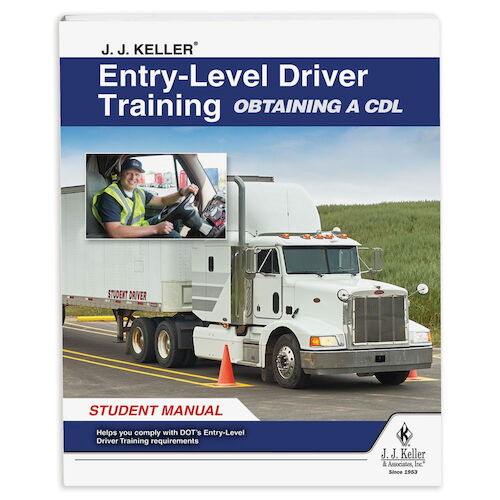Have you ever thought about the level of skill and knowledge required to become a professional truck driver? Navigating the FMCSA Curriculum: Entry Level Driver Training Essentials sheds light on the comprehensive training required to ensure the safety and proficiency of entry-level drivers. With each passing day, the roads become more congested and driving conditions increasingly challenging. It is crucial that drivers are equipped with the necessary skills and knowledge to navigate these obstacles effectively.
Navigating the FMCSA Curriculum: Entry Level Driver Training Essentials addresses the need for a standardized and rigorous training program for entry-level drivers. With a rich history of accidents and incidents involving inexperienced drivers, it is clear that a comprehensive training program is essential. In fact, according to the Federal Motor Carrier Safety Administration, in 2018 alone, there were over 4,000 fatal crashes involving large trucks. By implementing a curriculum that covers crucial topics such as safe driving techniques, vehicle inspection, and hours-of-service regulations, we can work towards reducing accidents and ensuring the safety of everyone on the road.
Looking to ace the FMCSA curriculum? Here are some essential tips to guide your entry-level driver training:
– Familiarize yourself with FMCSA regulations
– Study the core subjects thoroughly
– Attend specialized training sessions
– Utilize online resources for additional learning
– Practice with sample questions and mock exams
Remember, mastering the essentials is key to successfully navigating the FMCSA curriculum!

Navigating the FMCSA Curriculum: Entry Level Driver Training Essentials
Driving a commercial vehicle requires specialized skills and knowledge to ensure safety on the road. The Federal Motor Carrier Safety Administration (FMCSA) has developed a comprehensive curriculum for entry-level driver training to equip aspiring truck drivers with the necessary expertise. Navigating through the FMCSA curriculum may seem daunting, but understanding its essentials is crucial to becoming a skilled professional. In this article, we will delve into the key components of the curriculum and provide valuable insights to help aspiring drivers successfully navigate through their training.
The Importance of Entry Level Driver Training
With the increasing demand for truck drivers in the logistics industry, it is essential to have comprehensive and standardized training in place. The FMCSA curriculum for entry-level driver training aims to ensure that all commercial drivers possess the necessary skills, knowledge, and qualifications to operate safely on the roads. The training covers a wide range of topics, including vehicle operations, highway safety, hours of service regulations, and defensive driving techniques. By completing this training, aspiring drivers will not only enhance their employability but also contribute to overall road safety.
One of the essential aspects of entry-level driver training is the emphasis on safety. Commercial vehicles require a higher level of skill and awareness than regular automobiles due to their size and weight. The FMCSA curriculum is designed to instill safe driving practices, promote compliance with federal regulations, and develop a strong understanding of potential risks and hazards. Through this training, drivers will learn how to handle various driving situations, prevent accidents, and properly respond to emergencies on the road.
The Components of the FMCSA Curriculum
The FMCSA curriculum consists of several key components that are essential for entry-level drivers. These components include classroom instruction, behind-the-wheel training, and a comprehensive assessment. The classroom instruction covers various topics, including vehicle systems and controls, safe driving techniques, transportation regulations, and cargo handling. During this phase, instructors provide theoretical knowledge and engage in discussions to ensure a comprehensive understanding of the subject matter.
After completing the classroom instruction, aspiring drivers move on to the practical training phase. This phase focuses on hands-on experience and familiarization with the commercial vehicle. Students will go behind the wheel and learn how to operate the vehicle safely, perform maneuvers, and make critical decisions on the road. Instructors closely supervise and guide the students, providing valuable feedback and corrections to enhance their skills.
The final component of the curriculum is the assessment phase, where students undergo a comprehensive evaluation to gauge their competency. This assessment includes a written examination to test theoretical knowledge and a skills test to assess practical driving abilities. Successful completion of the assessment is a requirement for obtaining a commercial driver’s license (CDL) and pursuing a career as a professional driver.
The Benefits of FMCSA Curriculum Compliance
Complying with the FMCSA curriculum for entry-level driver training offers several benefits for both drivers and the industry as a whole. Firstly, it ensures that drivers are equipped with the necessary skills and knowledge to operate commercial vehicles safely and efficiently. This contributes to improved road safety, reduced accidents, and fewer fatalities on the highways.
Additionally, compliance with the FMCSA curriculum enhances the professionalism of the trucking industry. By setting a standard for training and qualification, it helps raise the overall quality of drivers and establishes a benchmark for employers to hire qualified individuals. This ultimately leads to a more reliable and efficient logistics sector and promotes a positive image for the industry as a whole.
Furthermore, compliance with the FMCSA curriculum opens up opportunities for aspiring drivers. By completing the training and obtaining a CDL, individuals can explore various career options within the trucking industry. Whether it’s long-haul trucking, local delivery, or specialty transportation, the comprehensive training received through the curriculum serves as a solid foundation for a successful career in the field.
Tips for Success in Navigating the FMCSA Curriculum
Navigating through the FMCSA curriculum can be demanding, but with the right approach, aspiring drivers can succeed in their training. Here are some tips to help you make the most of your training experience:
- Stay organized: Keep track of your training materials, schedules, and assignments to ensure you stay on top of your progress.
- Ask questions: Don’t hesitate to seek clarification from your instructors if you have any doubts or need further explanations.
- Practice outside of class: Use any available opportunities to gain additional practice behind the wheel and reinforce what you’ve learned in the classroom.
- Review regularly: Regularly review your notes and study materials to strengthen your knowledge and retain information for the assessments.
- Stay up to date: Keep yourself informed about any updates or changes in regulations and industry practices to ensure compliance and stay ahead in your training.
The Future of Entry Level Driver Training
As the transportation industry continues to evolve, the FMCSA curriculum for entry-level driver training will also undergo updates to reflect the changing landscape. Technological advancements, such as the integration of automation and electronic logging devices, may play a significant role in shaping the future of training. The curriculum will likely include modules on these emerging technologies to prepare drivers for the challenges and opportunities they present.
Moreover, the collaboration between industry stakeholders, including trucking companies, training schools, and regulatory bodies, will be essential in further refining and enhancing the curriculum. Regular assessments of industry needs and feedback from drivers and instructors will ensure that the training remains relevant and effective in producing highly skilled and qualified commercial drivers.
In conclusion, navigating through the FMCSA curriculum for entry-level driver training is a crucial step towards becoming a skilled and qualified professional in the trucking industry. By understanding the importance of the training, adhering to the curriculum’s components, and implementing effective strategies for success, aspiring drivers can embark on a rewarding career path while contributing to overall road safety and industry standards.
Statistics show that compliant, well-trained drivers have a lower accident rate by 2.5 times, contributing to safer roads and reduced injuries and fatalities.
Key Takeaways: Navigating the FMCSA Curriculum – Entry Level Driver Training Essentials
1. Safety is the top priority when it comes to training new commercial drivers.
2. The FMCSA curriculum provides a structured program to ensure comprehensive training.
3. Understanding regulations, hours of service, and vehicle maintenance is crucial for entry-level drivers.
4. Effective communication skills and the ability to handle emergencies are essential for professional drivers.
5. Continuous learning and staying updated with industry changes is important for a successful driving career.
Frequently Asked Questions
Welcome to our FAQ section on navigating the FMCSA curriculum for Entry Level Driver Training essentials. Here, you’ll find answers to common questions about this important topic. Whether you’re a new student or an experienced driver looking to refresh your knowledge, we’ve got you covered. Read on to learn more!
1. What is the FMCSA curriculum for Entry Level Driver Training?
The FMCSA curriculum for Entry Level Driver Training is a set of guidelines and requirements established by the Federal Motor Carrier Safety Administration (FMCSA) in the United States. It defines the essential training elements that commercial driver’s license (CDL) applicants must complete before obtaining their CDL. The curriculum covers a range of topics, including vehicle operation, safety regulations, hours of service, and more.
The goal of this curriculum is to provide comprehensive training that ensures entry-level drivers have the necessary knowledge and skills to safely operate commercial vehicles on public roads. It helps to standardize training programs across the country, promoting consistency and enhancing road safety.
2. Who is required to follow the FMCSA curriculum for Entry Level Driver Training?
All individuals applying for their commercial driver’s license (CDL) in the United States are required to follow the FMCSA curriculum for Entry Level Driver Training. This includes individuals seeking to obtain a CDL for the first time, as well as those renewing or upgrading their existing CDL. The curriculum applies to both Class A and Class B CDL applicants.
It’s important to note that each state has its own process for implementing the FMCSA curriculum. Some states may require additional training beyond the FMCSA minimum requirements. It’s crucial to check with your state’s Department of Motor Vehicles (DMV) or equivalent agency to understand their specific training requirements.
3. How can I navigate the FMCSA curriculum for Entry Level Driver Training?
Navigating the FMCSA curriculum for Entry Level Driver Training can be a straightforward process if you follow these steps:
1. Familiarize yourself with the FMCSA requirements: Start by reading the FMCSA regulations and guidelines related to Entry Level Driver Training. Understand what topics are covered and the minimum number of training hours required.
2. Choose a reputable training provider: Look for training providers that are approved by your state’s DMV or equivalent agency. Ensure they offer the necessary curriculum and have a good reputation for providing quality training.
3. Enroll in a training program: Once you’ve chosen a training provider, enroll in their Entry Level Driver Training program. Make sure the program meets the FMCSA requirements and is tailored to your specific CDL goals (Class A or Class B, for example).
4. Complete the training: Attend all training sessions and actively engage in the learning process. Take advantage of any additional resources provided by the training provider, such as study materials or practice tests.
5. Pass the knowledge and skills tests: Once you’ve completed the training, you’ll need to pass both the knowledge and skills tests administered by your state’s DMV or equivalent agency. Study diligently and practice your driving skills to increase your chances of success.
4. What are the benefits of following the FMCSA curriculum for Entry Level Driver Training?
Following the FMCSA curriculum for Entry Level Driver Training offers several benefits:
1. Enhanced safety: The curriculum ensures that entry-level drivers receive comprehensive training on critical aspects of safe commercial vehicle operation. This promotes safer driving practices and reduces the risk of accidents on the road.
2. Compliance with regulations: By following the curriculum, you’ll be in compliance with the FMCSA regulations, which are designed to improve industry standards and promote uniformity in training programs.
3. Improved job prospects: Many trucking companies prefer to hire drivers who have completed the FMCSA-approved curriculum. By completing this training, you enhance your employability and open up potential job opportunities.
4. Enhanced knowledge and skills: The curriculum covers a wide range of topics relevant to commercial driving. By completing the training, you’ll gain a comprehensive understanding of these topics, improving your overall knowledge and skills as a commercial driver.
5. Are there any additional resources available to help navigate the FMCSA curriculum for Entry Level Driver Training?
Yes, there are several additional resources available to help navigate the FMCSA curriculum for Entry Level Driver Training:
1. FMCSA website: Visit the FMCSA website for detailed information on the curriculum requirements, regulations, and additional resources.
2. State-specific resources: Check your state’s DMV or equivalent agency website for state-specific training requirements and resources.
3. Training provider materials: Many training providers offer study materials, practice tests, and other resources to help you navigate the curriculum. Take advantage of these resources to enhance your learning experience.
4. Online forums and communities: Join online forums or communities of commercial drivers to connect with others who have navigated the FMCSA curriculum. They can provide insights, tips, and support throughout your training journey.
To summarize, the FMCSA Curriculum for entry level driver training is a vital resource for new drivers. It covers essential topics such as regulations, vehicle operation, and safety procedures. By following this curriculum, new drivers can gain the necessary knowledge and skills to safely navigate the roads. It is crucial to approach the training with a professional mindset and adhere to the guidelines to ensure effective learning. By doing so, drivers can become competent and responsible professionals in the transportation industry.
In conclusion, the FMCSA Curriculum provides the necessary foundation for entry level driver training. By following its essentials and adopting a professional approach, new drivers can develop the skills needed to become safe and competent drivers. This training is a critical step in ensuring the safety of both the drivers themselves and others on the road.






